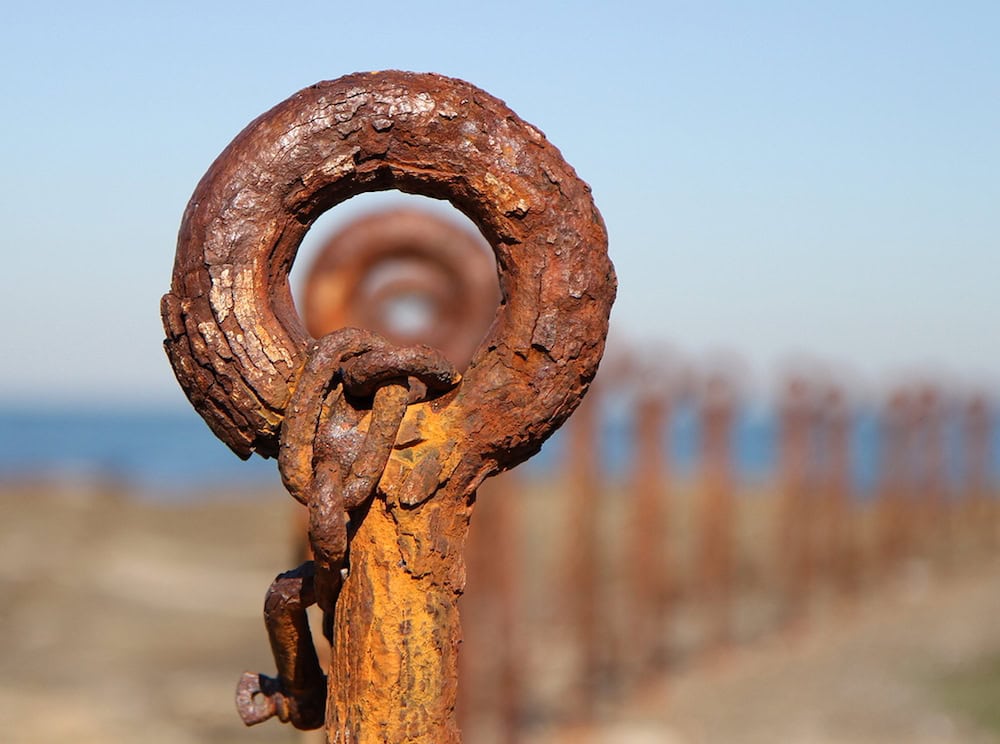
[Image above] Rust is a common problem for infrastructure, but when combined with saltwater, it can be a source of electricity. Credit: Bill Collison, Flickr (CC BY-NC 2.0)
It is no surprise that expensive military weapons and programs make up a substantial part of the Department of Defense (DOD) budget. Yet there is another, less known item that costs the Pentagon more money annually than many of the expensive weapons systems—rust.
Rust costs the Pentagon up to $21 billion per year. Corrosion of metals is such a large problem that the DOD established the Office of Corrosion Policy and Oversight in 2002 to help branches determine how much money to spend on rust prevention and to ensure oxidation does not take big-dollar weapons systems offline.
From the viewpoint of DOD, rust is a problem to suppress. However, in other situations, rust may be beneficial.
In a paper published last week in the Proceedings of the National Academy of Sciences, researchers at the California Institute of Technology and Northwestern University show that rust could offer a new means of sustainable power production. They demonstrated rust can generate electricity when saltwater runs over it.
Electricity is often generated via interactions between metal compounds and saltwater (think of batteries). However, electricity generated this way is usually the result of a chemical reaction in which one or more compounds are converted to new compounds.
In the case of rust, electricity is generated from kinetic energy of the flowing saltwater, a phenomenon known as the electrokinetic effect. Studies testing this effect on carbon nanotubes, graphene, and dielectric-semiconductor architectures have demonstrated promising conversion efficiencies of 30%. In comparison, some of the best solar panels are around 20%.
Fabricating carbon nanostructured films of usable size, though, is difficult. But rust does not face that limitation.
“It’s basically just rust on iron, so it’s pretty easy to make in large areas,” Thomas Miller, Caltech professor of chemistry, says in a Caltech press release. “This is a more robust implementation of the thing seen in graphene.”
The researchers used physical vapor deposition (PVD) to deposit nanolayers of iron, nickel, vanadium, aluminum, and chromium in 5, 10, 20, and 50 nm thick layers on glass slides. When the slides were removed from the PVD machine, the metals spontaneously oxidized in air.
The researchers flowed saltwater solutions of varying concentrations over the oxidized slides and found slides with iron, vanadium, and nickel nanolayers produced open-circuit potentials of several tens of millivolts and current densities of several microamps per cm2.
In the paper, the researchers explain why these oxidized metals demonstrated better results than aluminum and chromium. “Structures whose oxide nanooverlayers contain only a single oxidation state, such as those formed from [aluminum] or [chromium] metal, should still produce currents due to contact electrification, but the lack of intraoxide electron transfer would diminish their current output,” they say.
In the press release, Miller says the electrokinetic effect could be useful in scenarios involving moving saline solutions.
“For example, tidal energy, or things bobbing in the ocean, like buoys, could be used for passive electrical energy conversion,” he says. “You have saltwater flowing in your veins in periodic pulses. That could be used to generate electricity for powering implants.”
The paper, published in Proceedings of the National Academy of Sciences, is “Energy conversion via metal nanolayers” (DOI: 10.1073/pnas.1906601116).
Author
Lisa McDonald
CTT Categories
- Basic Science
- Energy
Related Posts
‘Fairy circles’ may help mark natural underground hydrogen deposits
September 18, 2025


